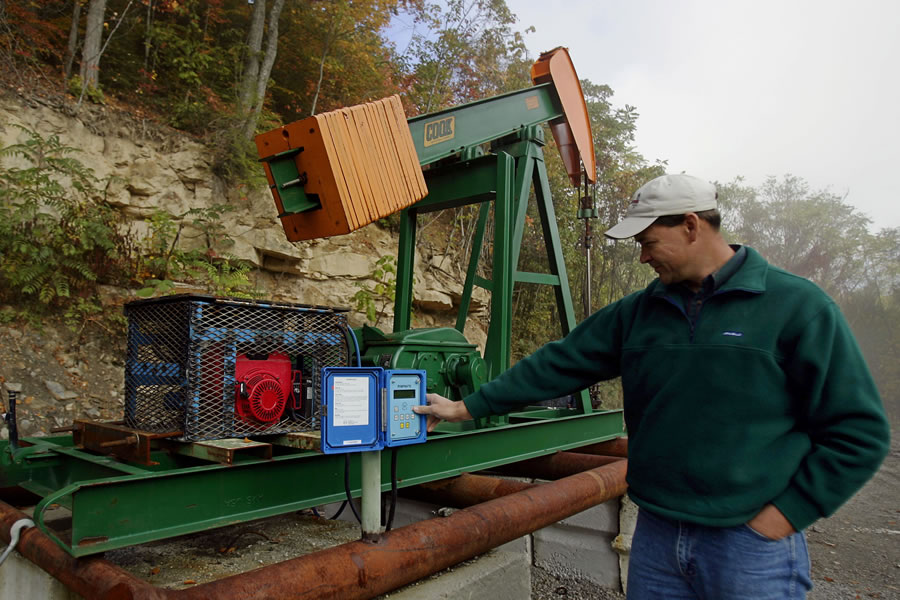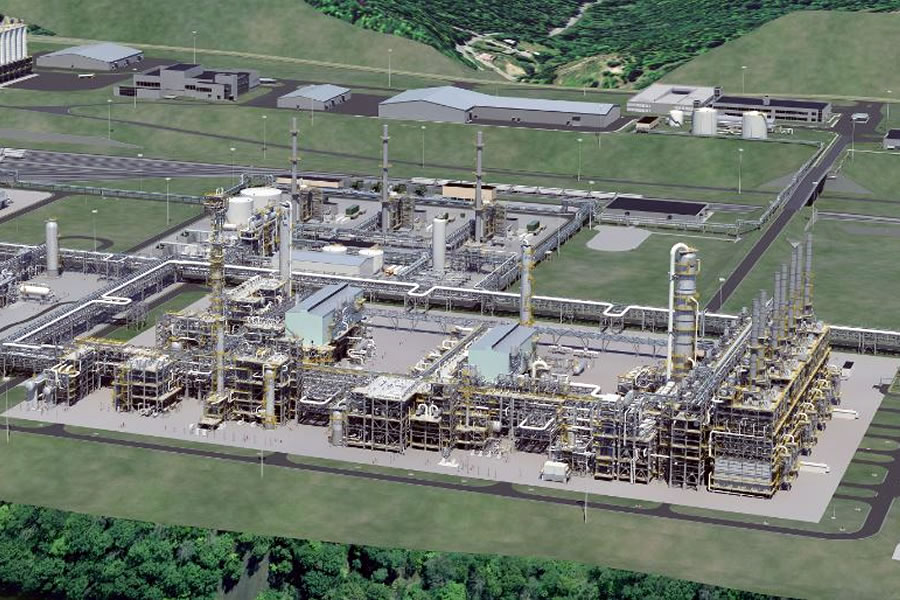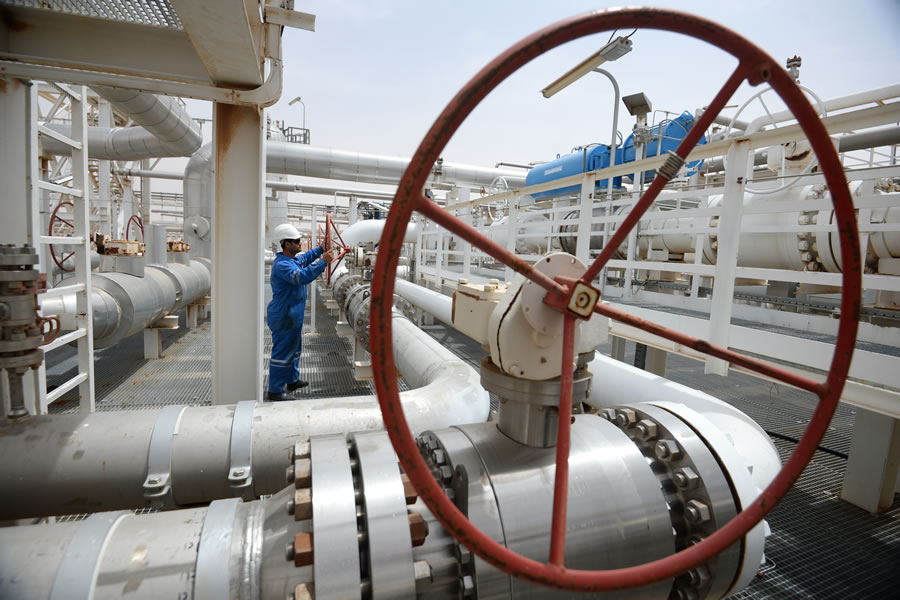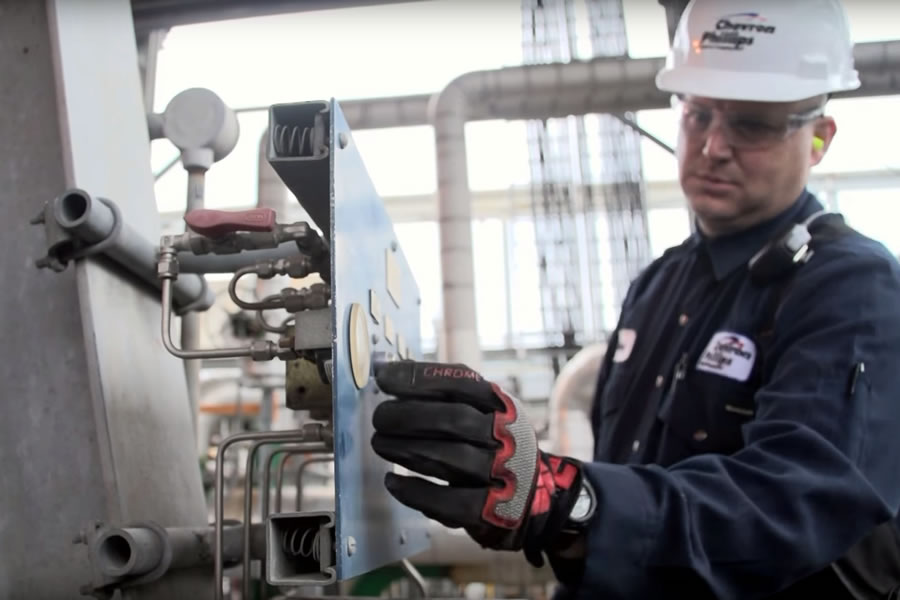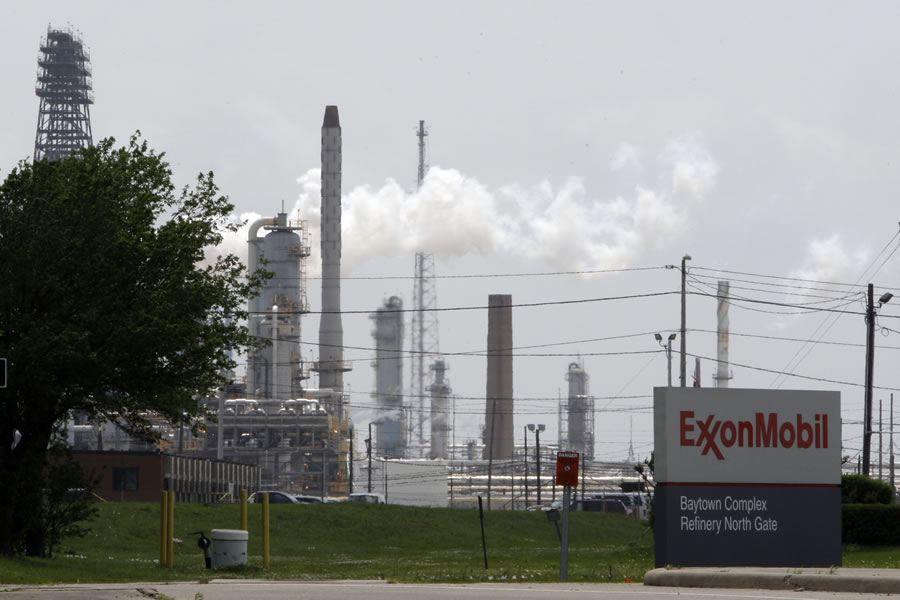The US Appalachia region (in particular, Pennsylvania, West Virginia and Ohio), whose shale rocks have been found to contain a vast amount of "wet" natural gas, is poised to become a viable competitor to Texas’ petrochemical complex. At the same time, for the economic potential of the staggering amount of gas and the future ethane crackers to be realised, gas products need to open up new global markets.
“Rich, rich, rich, rich.” That is energy analyst Taylor Robinson describing the economic potential of the vast amount of "wet" natural gas in the shale rocks of Appalachia's Ohio River region. This has been recognised since the hydraulic fracturing revolution began a decade ago in the Marcellus Shale formation lying thousands of feet down in Pennsylvania, West Virginia and Ohio. It has been repeated as the deeper Utica Shale layers were drilled.
Gas production at the Marcellus Shale formation.
The full exploitation of Marcellus and Utica resources could in time create 25,000 jobs in chemical and plastics manufacturing.
The rocks are loaded with natural gas liquids – ethane, propane and other chemical cousins that are mingled in the more common methane heating gas. These more complex hydrocarbons are raw materials for a host of chemical and plastic products that are seeding dreams of a manufacturing renaissance in economically downcast Appalachia. The Mid-Atlantic Technology, Research and Innovation Center (MATRIC) in South Charleston, W.Va., has published an estimate that a full exploitation of Marcellus and Utica resources could in time create 25,000 jobs in chemical and plastics manufacturing.
“The shale gas is very wet and rich and very low-cost,” says Robinson, president of PLG Consulting, whose research work includes the Appalachian shale gas resources. In some parts of the region, the natural gas contains up to 65% ethane and other gas liquids, and 40% is common, Robinson said, creating a fertile building block for plastic products.
The Appalachian natural gas resources are seeding dreams of a manufacturing renaissance in the region.
In some parts of the region, natural gas contains up to 65% ethane and other gas liquids creating a fertile building block for plastic products.
Without doubt, the region owns a hydrocarbon windfall opened up by fracking and horizontal drilling advances. “The Marcellus Shale resource alone represents the second largest natural gas field in the world,” the IHS Markit consulting firm concluded in a report this spring. But today, just a small part of the region's potential ethane production moves by pipeline to Philadelphia, Canada and the Gulf Coast because there is little else to do with it. “There is a lot of trapped ethane in that region that needs a home,” Robinson said.
In search of a market
Now, the first home is under construction by Shell Chemicals along the Ohio River in Beaver County, Pa., 30 miles northwest of Pittsburgh. Shell's steam cracking plant will break ethane apart and reconstitute it as ethylene gas. Three production units will then link ethylene molecules to create polyethylene plastic pellets, a ubiquitous component of packaging and housewares products. Through the same process, propane winds up as polypropylene fibres and resins, turned into carpets and high-performance plastics. Shell's plant is set to open in late 2021 or early 2022. It will generate an estimated USD 9–12 m in income taxes and more than USD 3 m in local taxes a year, according to an analysis commissioned by the company. When running, it will have a payroll of 600 workers and provide work for two to three times that number in its supply chain, Shell says.
The first steam cracking plant is under construction by Shell in Beaver County, Pa.
Ohio hopes the next cracker is on its turf. In March, Gov. John Kasich (R) announced a stepped-up investment commitment by Thailand's PTT Global Chemical and South Korea-based Daelim Industrial Co., Ltd. for a proposed cracking plant in Belmont County, in the heart of Utica's "wet" shale gas area. Kasich said he is hoping for a go decision by the end of this year on a project that could be worth up to USD 10 bn.
Two-thirds of the increased US natural gas production since 2012 has come from the Appalachia shale region.
The amount of ethane that could be raised from the Marcellus Shale would justify construction of four more "world-scale" crackers in addition to the Shell plant, IHS Markit calculates. But production of Appalachian ethane's derivative products would likely swamp what the US economy can absorb, according to IHS Markit and other analysts. That means an ethane breakout along the Ohio River sets up the potential for a showdown duel between that region and the heart of the US petrochemical industry along the US Gulf Coast. “You are going to have a very competitive feedstock in that region,” said Robinson about the Appalachian resources, “until you have too many crackers.”
Two-thirds of the increased US natural gas production since 2012 has come from the Appalachia shale region, noted Warren Wilczewski, the US Energy Information Administration's expert on the region's gas resource. Gas liquids production from Pennsylvania alone, which was negligible in 2005, had jumped to an average of 50,000 barrels a day in 2011–2015, and IHS sees the total climbing to nearly 200,000 barrels daily in 2021–2025. For the combined East Coast and Midwest regions, ethane production is forecast to hit an average of nearly 800,000 barrels a day in 2021–2025. If that happens, one-quarter of that total would have to be exported, if foreign buyers can be found, in order to balance US supply and demand, the consulting firm says.
If the current estimates are correct, the USA will have to export a quarter of its ethane output by 2021–2025.
Pros and cons
Analysts fear that success for Appalachia would mean taking business away from the extraordinary complex of gas and petrochemical facilities on the US Gulf Coast. For their part, leaders of the Gulf Coast petrocomplex are not showing any anxiety.
The region will be hard-pressed to catch up with the giant well-oiled machine of Texas and the rest of the US Gulf Coast’s petrochemical expanse.
Wilczewski says that Appalachia will be hard-pressed to catch up with the giant well-oiled machine of Texas and the rest of the US Gulf Coast's petrochemical expanse, which includes huge, invaluable natural storage chambers for wet gas centred in the Mont Belvieu area east of Houston. Appalachia's first comparable ethane storage facility is still on the drawing board.
“There isn’t a single petrochemical company in the world that isn't salivating at the capacity Gulf Coast producers have. I don't know how to overstate the advantage that provides those producers. I don't think it's possible to build anything like that anywhere on Earth,” Wilczewski said. But Appalachia has other advantages, he adds. The IHS Markit analysts put ethylene costs from Appalachia 23% lower than on the Gulf Coast. In addition, around 70% of the manufacturing plants that use ethane polymers in their manufacturing are within 700 miles of Pittsburgh, IHS Markit said. Delivery times for polyethylene within the region can be a week or less, but up to three weeks by rail from the Gulf Coast, the firm said.
Texas stands ground
Chevron Phillips Chemical Company LP has announced that it has begun operating a new ethane cracker at its Cedar Bayou facility in Baytown, Texas. At peak production, the unit will produce 1.5 mt / 3.3 bn lbs of ethylene per year, making it one of the largest and most energy efficient crackers in the world. In September 2017, the company announced the successful commissioning and start-up of two new Marlex® polyethylene units in Old Ocean, Texas, based on the company’s proprietary MarTECH® technologies. Together, these assets form the bulk of the company’s US Gulf Coast Petrochemicals Project (USGCPP), which was first announced in 2011.
Ethylene produced by the new ethane cracker at Cedar Bayou will be used to meet the needs of the company’s derivative units, including the two new polyethylene units at Old Ocean, Texas, which are capable of producing a wide variety of products, ranging from metallocene linear low-density polyethylene to Advanced Dual Loop bimodal polyethylene resins. These resins are turned into consumer and industrial products such as plastic films for food safety and preservation; and polyethylene pipe for water distribution and natural gas transport. In addition, the ethylene will feed the company’s AlphaPlus® normal alpha olefins plants which are used extensively for polyethylene comonomers, plasticisers, synthetic motor oils, lubricants, automotive additives, surfactants, paper sizing, and in a wide range of other specialty applications.
Chevron Phillips Chemical Company LP has begun operating a new ethane cracker in Baytown, Texas.
For the combined East Coast and Midwest regions, ethane production is forecast to hit an average of nearly 800,000 barrels a day in 2021–2025.
“Born from the shale revolution that is providing low-cost feedstock, the US Gulf Coast Petrochemicals Project is the most transformational project in the history of our company,” said Mark Lashier, president and CEO of Chevron Phillips Chemical. “Our company and our growing employee base, the communities we call home, and the entire Gulf Coast region’s economy will benefit for decades to come as our project comes to life.”
Global demand aspirations
Baytown, Texas is also home to ExxonMobil’s new 1.5 mtpa ethane cracker that is part of the company’s integrated chemical and refining complex. The new cracker will provide ethylene feedstock to new performance polyethylene lines at the company’s Mont Belvieu plastics plant, which began production at the tail end of 2017. The Mont Belvieu plant is one of the largest polyethylene plants in the world, with manufacturing capacity of about 1.3 mtpa.
ExxonMobil is expanding its Texas petrochemical facilities in large part due to the vast volumes of ethane that are becoming available due to the region’s intense shale activity. Together, the Baytown ethane cracker and the Mont Belvieu plant represent ExxonMobil’s largest chemical investment in the US to date. Operations associated with the Baytown and Mont Belvieu projects are expected to increase regional economic activity by roughly USD 870 m per year and generate more than USD 90 m per year in local tax revenues.
Commenting on the start-up of the new cracker, John Verity, president of ExxonMobil Chemical company, said:
“Our new ethane cracker will help us meet the growing global demand for high performance plastic products that deliver key sustainability benefits such as lighter packaging weight, lower energy consumption and reduced emissions, further enhancing our competitiveness worldwide. The abundance of domestically produced oil and natural gas has reduced energy costs and created new sources of feedstock for US Gulf refining and chemical manufacturing while creating jobs and expanding economic activity in the area.”
The town is also home to ExxonMobil’s new ethane cracker, part of its integrated chemical and refining complex.
ExxonMobil’s more than USD 20 bn Growing the Gulf expansion programme consists of major chemical, refining, lubricant and liquefied natural gas projects at proposed new and existing facilities along the Texas and Louisiana coasts. Investments began in 2013 and are expected to continue through at least 2022.
Source: E&E News Energywire
Download PDF


